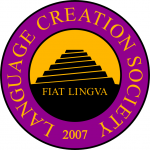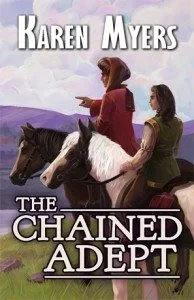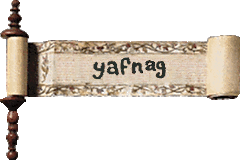Yet Another Fantasy Name Generator – one of the better ones, actually, says fantasy author Karen Myers (http://dicelog.com/yafnag)
My reading resolution for 2016 is to get over my aversion to made-up names – a childish prejudice that forms a barrier to my enjoyment of a lot of fantasy books, and prevents me trying to read more. Although I'm interested in foreign languages and have studied French, German and Greek over the years, I find it irritating to encounter a language that makes no sense to me at all, and whose logic I cannot follow. I was therefore very interested to learn from US fantasy writer and ALLi Professional Member Karen Myers about a much more thorough, realistic and scholarly approach to creating languages for use within fantasy worlds.
Karen's newly released novel, The Chained Adept, includes four nations with different cultures and languages, in a full fantasy world (in other words, not just Earth under some other guise). She wrote it with placeholder names while seeking the creation of suitable names to substitute later in the process. Over to Karen to explain how the process worked for her, what she learned along the way, and why she's committed to using this system in future for other fantasy worlds she's creating.

US indie author of fantasy novels Karen Myers (Photo by Sarah Dane)
I may have a shallow linguistics background in a dozen languages (and I do), but that’s just not enough to provide suitable linguistic depth for my world. While full-world fantasies are often content to let many conventional earthly things appear unchanged, such as the air we breathe, the horses we ride, the sun in the sky, and the tasty beer, that is more in the nature of not having to explain absolutely every noun in a story to your readers. Those things are thought of as transparent, part of the background against which you set the actual story with its exotic cultures.
That carefully-crafted exotic flavor sours quickly if your characters are named Sam and Susie, or if their language and cultural artefacts are internally inconsistent, or indistinguishable from the usage of their enemies in another country.
How NOT to Create A Fantasy Language
Unless you model your cultures on real-world languages fairly closely, it’s easy to find yourself out of your depth in linguistic plausibility.We’ve all read fantasies where the author just threw in a few names from an RPG name generator and called it a day, but I know too much about real languages to stomach that approach and, besides, why stop at personal names? Why not include special terms for the exotic elements of the different cultures, using the appropriate languages, just as we refer to Japanese sushi, or French je ne sais quoi, or Sanskrit karma, all of which describe a cultural item in the native language? Why not make sure all the names in the landscape really are plausibly from the appropriate languages, possibly reflecting a history of border shifting or older populations?
J R R Tolkien is the great exception. As a professional philologist, he was well-qualified to construct his various dialects of Elvish and the other languages with which he amused himself (and us). I love the feel of depth that Tolkien’s worlds contain, and I know enough to understand how his languages work to help achieve that, but I can’t do it myself, at least not well enough.
 So I went looking for someone who can.
So I went looking for someone who can.
How to Work with Specialist Conlangers
You can read at length here about how people who create CONstructed LANGuages (Conlangers) are organized and how they view partnership opportunities.
You can also read on my Hollowlands blog a detailed account of the creation of my own constructed language for the world in The Chained Adept, but here is a bullet point summary of the process:
- Establish requirements in a brief sent to conlangers via the jobs board of the Language Creation Society
- Audition applicants
- With the successful applicant, establish a structure for a contract, with a very simple main contract and an attachment for each project, plus a set fee for additional words
- Co-design the background cultures (I had worked out some of the cultural background, but not at the level and specificity needed when we started putting linguistic terms together)
Much More Than the Sum of the Parts
I gave the conlanger a very free rein to go wild (within my initial guidance) in filling in needed areas. For example, I knew my Rasesni culture (defined initially as “vaguely Afghan”) would be a many-gods religious theocracy, but my conlang partner had to get into the nitty-gritty of deciding that priests would tend to take god-specific names, and how that would work, and the persistence of older forms of the religious language, and so forth and so on.
There were very many fruitful collaborations like this. The conlanger would propose some cultural details necessary for onomastics, and I would push back or clarify if I disagreed or if it created a specific issue (or I would change what I had written to accommodate a better idea). By the end, I was telling him how counting in couples worked for foxhounds, and he was defining naming systems where the word used for “half a couple” was also used metaphorically as “leftover” for an intercalendary month that had to be occasionally inserted to justify a lunar calendar.
This was terrific. It was worth the cost alone. Everything in the book (and series) will be far richer because of this, beyond just the conlang words themselves.
Respect the Conlanger's Skillset

This new release includes the language created in collaboration with specialist conlanger Damatir Ando
Don’t forget that conlangers are not fiction writers. I needed to explain why it’s helpful to have name choices with a wide variety of initial letters, to make it easier for readers to keep names straight, or why I couldn’t really use both a male and female version of the same name, any more than I would want to have both Robert and Roberta in the same novel.
I have another full-world fantasy in the wings and I plan to go the same route again for that, with the same conlang partner, if possible.
Editor's Note: If you're interested in using the services of a conlanger, do first read Karen's very detailed posts on her Hollowlands blog: Part 1, Part 2 and Part 3. There's also a longer version of the above post including a list of specific lessons learned along the way on her blog here.
OVER TO YOU Do you have experience of working with a conlanger? Do you have an alternative solution you prefer? We'd love to know – and feel free to ask Karen questions too.
RELATED POSTS
- How Poetry Helped my Prose by Michael La Ronn
- Which Version of the English Language Do You Use? by Debbie Young
- Writing: The Grammar Principle by C S Lakin





Was looking for some takes regarding this topic and I found your article quite informative. It has given me a fresh perspective on the topic tackled. Thanks!
I’m writing a fantasy novel, and came up with a language that is not able to be typed. What would I do to try to type it on a computer?
[…] Writing: How to Create a Language for a Fantasy Novel World […]
I used to be suggested this website via my cousin. I am no longer certain whether or not this post is written via him as nobody else recognize such precise about my trouble. You’re wonderful! Thank you!
[…] post could be the starting point for […]
[…] Karen Myers My reading resolution for 2016 is to get over my aversion to made-up names – a childish prejudice […]
Keep in mind this is a created-world fantasy, not Earth with earthly cultures, much less a Regency Romance. Therefore, the horse is just a convenience, vs creating a completely unique ecosystem, usually a waste of time in many fantasies. That also means that the assumptions about breeds of horses, and so forth, are not relevant (no America, no Indians, no Arab horses). The paint horse in this case was supplied by an entirely different culture than the one that gives us the fellow in the robes. It’s true to a scene in the book.
So the paint horse was actually deliberate (she’s been given a slowpoke of a horse to inhibit her ability to escape). 🙂
I do agree that bogosity in a cover is a bad thing, and I loathe the clothing treatment of historical romances. But you can’t always tell… If the book’s got a wizard on the cover, it might not be what you think. 🙂
I find it interesting that you comment on the cover designer relationship in your reply to the previous comment. I realized, while reading this post, that truly getting cover images right for fiction is a very similar process to that for the language – that it is deeply layered in cultural subliminal associations and assumptions, and that it is a fine balance between leveraging those things from ‘our world’ and presenting those things that make the ‘world in the book’ unique.
I write, edit and publish, but I also have a long history in historical recreation activities, (sewing, cooking, physical activities etc), in graphics and in photography. This post has just crystallized for me exactly what it is about many covers that jars for me, and may make me not choose to buy the book ( in extreme cases). Thank you for that!
In fact, your cover image as shown here contains an example of that. Your description of your world in the text is primarily of cultures based around the Middle East / asiatic types of background feel. The cover image features a horse which appears to be a paint horse. And, as a lifelong horse person with a fascination for history, that’s an instant jar for me – whilst there are some ‘patches of color’ style horses in parts of Europe recorded fairly early, the primary existence of paint horses is in the Americas. So my mental assumption on first glance at the cover is that sort of setting – which then clashes with the more asiatic style of the clothing shown.
I see this sort of thing a lot on covers ( and, for that matter, in the descriptions in books) – where the baseline cultural environment of the cover designer has bled through into how they depict something, without them having any awareness of the fact (like American saddles on horses in British regency books…….).
Again, thank you – I really need to think about this further and capture these concepts re cover design into my already growing do I on what does and doesn’t work in cover design, beyond the blatantly obvious basics ( eventually I think I am writing a hook on this subject…..)
This looks fascinating! I’d like to write a type of fantasy after I finish my present series. Just had a peek at Hollowlands.com site too. The depth of this and skill of conlanger aligned with the author means you’d have to really be in sync with your conlanger.
I find it’s both similar to and different from working with a cover artist.
I have to refrain from telling my cover artist all about the story in the book and wasting his time. Better that I focus on the specific details in the cover illustration. I do send him a book afterwards, but who know if he reads it? 🙂
For the conlanger, he has to know a great deal about the world you’re creating — I was delighted I could use mine as a co-designer the way I describe in the expanded version of this post.
I can come up with dozens of examples now, but let’s just take a couple. One of my languages/cultures (Zannib) is “vaguely Arabic”. What that means is, the reader, when seeing the words, shouldn’t really be subliminally surprised if the people using them are nomadic, or that they value water sources, or wear robes and turbans. That’s why I use the concept of something recognizable in the real world, so I don’t have to spell out absolutely everything, since the reader will take some of it for granted. It’s like when you describe a character as stout, you don’t also have to spell out that they have trouble catching their breath and they hate climbing stairs — the reader already “knows” that, unless contradicted by explicit statements.
Now, the actual cultural model for the Zannib is more Mongolian than Arabic, but readers wouldn’t recognize the feel of a faux-Mongolian language, the way they would a faux-Arabic. So in that language, when the nomadic dwelling is a yurt, I have a choice. I can just call it a “yurt” the way I might say “tent” for a generic structure. But “yurt” feels to me like a still-vivid borrowing from a culture that wouldn’t necessarily use faux-Arabic words — the two things clash. So I use a conlang term for the yurt: “kazr, plural kazrab”. It’s still a yurt in most ways, but the word fits the faux-Arabic language and doesn’t jar the ear of the reader.
One character is from the culture of Ellech. She is a wizard, and that’s the word she uses. She travels with a man from Zannib. The word in his language for wizard is bikraj (bijrajti (f), bikrajab (pl)). Some of the foreigners he talks to don’t have wizards, so he’s accustomed to using his own language’s word for it.
She talks to him about “wizards”, and he talks to her about “bikrajab”. In her language, you wouldn’t call someone “wizard” as a title, as in “Hello, wizard,” but in his language it is a polite title, as in “Greetings, bikrajti.” When he gives her an affectionate nickname, it’s in his language rules, not hers.
These are just a few of the many trivial examples of increased subtlety and depth. There’s a constant evaluation about trade-offs between burying the reader in pointless specialty words vs a frequent if subliminal reminder about the different flavors of the different cultures. I may not be expert at this yet, but I know what I’m aiming at.
One of the writers I know who manages this most elegantly is JW Hicks, author of Rats. She has the knack of creating words that sound apt and alien at the same time, and using them in such a way as to effortlessly convey their meaning. Here she is talking about how she does it.
http://triskelebooks.blogspot.co.uk/2014/06/jw-hicks-on-language.html
[…] Source: Writing: How to Create a Language for a Fantasy Novel World […]